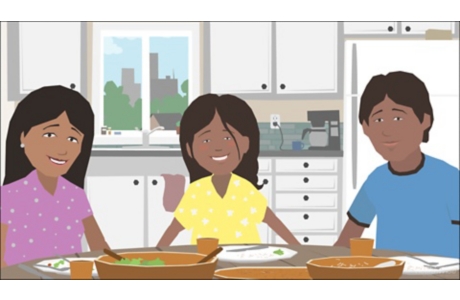Diabetes in Children: Food Issues at School
Overview
Learning how to manage their diabetes at school can be a big challenge for children. It may also bring changes to their school day as they learn to find time to care for their illness. But it can also be an opportunity for them to start taking more responsibility for their own health.
Part of that means learning how to eat the right foods at the right times and get lots of exercise. It can also mean teaching classmates what diabetes is and what the shots and blood sugar meters are for.
You can help your child by working with the doctor or diabetes educator to create a diabetes care plan for school. And you can keep your child's teachers, coaches, and other school staff informed about how to give diabetes care and manage blood sugar emergencies. A care plan will help you share this information with school staff.
Diabetes care plan
A diabetes care plan for school is a document that includes information the school staff needs to manage your child's diabetes. The goal is to meet your child's daily needs and prepare ahead of time for any problems.
The plan includes:
- Foods your child can eat, how much, and when. For example, if your child needs to eat shortly after taking insulin, a teacher or other adult can make sure this happens.
- How to give insulin to your child and how much insulin to give.
- When to test your child's blood sugar.
- Symptoms to watch for. Describe your child's symptoms of low or high blood sugar and how to treat them.
- Who to call. List parent(s), other caregivers, and your child's doctor. Explain when to call for help in case of an emergency.
It's a good idea to discuss the plan with the school staff at the start of each school year.
Food issues
If your child takes insulin, make sure that the diabetes plan has information about snacks. Teachers and coaches need to know that snacks keep your child's blood sugar at the right level. Tell them that they shouldn't prevent your child from having snacks. And tell them when your child usually needs snacks—for example, before, during, or after exercise.
Your child can eat regular school lunches. Help your child learn to make the best food choices.
Ask the school to let you know ahead of time if meals will be delayed because of special school activities, such as parties or trips. Then you can adjust your child's insulin or snack schedule to prevent a low blood sugar episode.
Have your child carry a quick-acting source of carbohydrate to eat if your child's blood sugar gets too low. These include:
- Foods that raise blood sugar very fast, such as glucose tablets or juice.
- Foods that raise blood sugar more slowly, such as pretzels, snack crackers, or a sandwich.
It's a good idea to ask your child's teacher to keep snacks like these close by.
Credits
Current as of: October 2, 2023
Author: Healthwise Staff
Clinical Review Board
All Healthwise education is reviewed by a team that includes physicians, nurses, advanced practitioners, registered dieticians, and other healthcare professionals.
Current as of: October 2, 2023
Author: Healthwise Staff
Clinical Review Board
All Healthwise education is reviewed by a team that includes physicians, nurses, advanced practitioners, registered dieticians, and other healthcare professionals.
This information does not replace the advice of a doctor. Healthwise, Incorporated, disclaims any warranty or liability for your use of this information. Your use of this information means that you agree to the Terms of Use. Learn how we develop our content.



